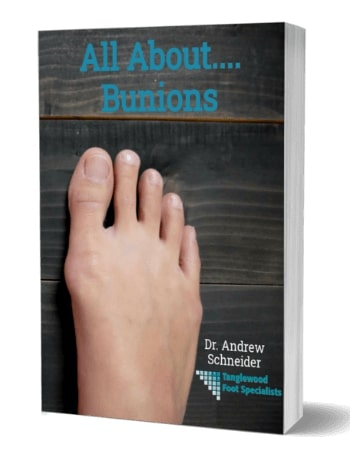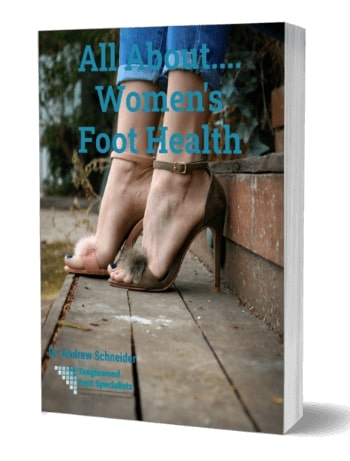One day you look down at your foot and start to see a bump forming on the side of your great toe joint. Where have yo u seen that before? Possibly in your mother’s or grandmother’s feet! You know how bad her bunions got. How painful they were. How hard it was to fit into a shoe.
u seen that before? Possibly in your mother’s or grandmother’s feet! You know how bad her bunions got. How painful they were. How hard it was to fit into a shoe.
It doesn’t have to be that way!
What is a Bunion?
A bunion, or hallux valgus, is a bony bump that forms at the base of your great toe. It is an enlargement of the head of the metatarsal bone. It can also include a swelling of the soft tissue in the area. This is called a bursa. As the bump on the foot increases, it forces the big toe to move towards the other toes. Sometimes the big toe will be forced over or under the 2nd toe. This can cause toe pain and the formation of a hammer toe.
How Bunions Form on Your Foot

Bunions form because of weak mechanics of the foot. I see it often if you have flat feet. The instability of the foot causes the bone before your big toe to rotate. This rotation is what causes the bump on the side of your foot.
Although bunions are a common foot condition that occur in both men and women, it is more common in women. This is because high heels will force the big toe into a position that will make a bunion increase in size. While shoes can make a bunion worse, they are rarely the cause of them forming in the first place.
Bunions can also form because of a foot injury, arthritis, or other medical conditions. If one leg is longer than the other, it is common to get a bunion on the longer limb only. It's important to find out the cause of a bunion. It will guide how I treat it and prevent it from coming back.
Are Bunions Hereditary?
Do you have a close family member with a bunion? If so, it does increase your chances of forming a hallux valgus deformity yourself. This is because you inherit the foot type of your relatives. This includes the unstable mechanics that comes along with it.
You don't inherit the bunion itself. Almost no one is born with one. But you inherit the predisposition to forming a hallux valgus deformity. That's why it's so important to identify if you're starting to see the beginnings of a bunion forming. This might include seeing a small bump at the base of your big toe. It's best to get your foot checked with an x-ray, even if it doesn't hurt you yet. Don't wait to develop a severe bunion.
What Does Bunion Pain Feel Like?
 Pain from a bunion can include:
Pain from a bunion can include:
- A painful bump on the side of your foot beneath your big toe
- Redness and swelling of the skin on the bump of the bunion
- A bursitis forming in the area of the bump near your big toe
- Foot pain and difficulty wearing your favorite shoes
- Pain in your great toe joint when you are walking or running
- Stiffness of your big toe joint restricting foot function
- The formation of a corn between your great toe and second toe
Is That a Bunion at My Pinky Toe?
It is possible to develop a bunion at the base of your little toe as well. This is known as a tailor’s bunion or a bunionette. It forms for the same reasons as a bunion. Sometimes you can have a bunion and a tailor’s bunion form. Sometimes you will have one without the other.
How is a Bunion Diagnosed?
 Diagnosing a bunion is straightforward. First, a physical examination will reveal if what you are experiencing is a bunion. Next, digital foot x-rays will allow me to see the position of the bones and joints. This allows me to determine how progressed the hallux valgus deformity is. This will help to guide our conversation about the proper treatment for your bunion.
Diagnosing a bunion is straightforward. First, a physical examination will reveal if what you are experiencing is a bunion. Next, digital foot x-rays will allow me to see the position of the bones and joints. This allows me to determine how progressed the hallux valgus deformity is. This will help to guide our conversation about the proper treatment for your bunion.
Bunion Treatment Options
What Shoes Are Best for Bunion Patients?
It is helpful to have properly fitting comfortable shoes. This will stop your shoes from making your bunions worse. Your footwear should have plenty of room in the toe box. This will help to accommodate your bunion.
You also should limit the amount of time you are wearing high heeled shoes. High heels put more pressure on your forefoot. This increases the pressure around the bunion. If your great toe joint is stiff, wearing fashionable shoes will cause pain in the joint cause toe pain.
Narrow shoes are also important to avoid. They leave less room for the enlargement of bone and can cause irritation and pain. Some people find pain relief by simply wearing a shoe that is a little bit wider.
Does Nonsurgical Bunion Treatment Work?
 A bunion cushion is a good conservative treatment option when you are getting some pain on the bump of the bunion. These non-medicated bunion pads will serve as a cushioned buffer between your bunion and the shoe. This will allow you to wear your shoes more comfortably.
A bunion cushion is a good conservative treatment option when you are getting some pain on the bump of the bunion. These non-medicated bunion pads will serve as a cushioned buffer between your bunion and the shoe. This will allow you to wear your shoes more comfortably.
Are Bunion Correctors Any Good?
There are many devices available that claim to correct a bunion if you wear them. That is rarely the case. What these devices do is pull your big toe away from the other toes. This stretches and loosens the soft tissue. It will not correct the aspects of hallux valgus that involve the bone. You might get some relief of pain by wearing a bunion corrector. They generally can't follow through on their claims to be a true nonsurgical bunion treatment.
Treating Toe Pain from Bunions
You can treat the pain associated with a bunion by:
- Using over-the-counter anti-inflammatories, such as ibuprofen, when necessary
- Applying ice to the bunion to reduce inflammation. It is important not to keep ice on your foot for more than 20 minutes
- An cortisone injection can be used to reduce the inflammation. This is especially helpful when there is a bursitis formed over the bump of the bunion.
Custom Orthotics for Bunions
 A bunion forms due to weakened foot mechanics. Because of this, it is essential to restore stability to your foot. This will prevent the bunion from worsening over time. This stability is provided with the use of shoe inserts known as a custom orthotic.
A bunion forms due to weakened foot mechanics. Because of this, it is essential to restore stability to your foot. This will prevent the bunion from worsening over time. This stability is provided with the use of shoe inserts known as a custom orthotic.
To evaluate you for a custom orthotic, I perform an extensive biomechanical examination. Through this examination, I'm able to pinpoint the cause of your bunion deformity. I then take a mold of your foot and design the orthotic to balance your feet. I aim to neutralize the forces that are causing your bunion to grow.
When Invasive Bunion Surgery is Necessary

If you've exhausted conservative measures to manage your bunion pain, it may be time to consider bunionectomy surgery. I never recommend traditional bunion surgery for cosmetic reasons. The reasons to have a surgical procedure performed is when you have pain in the big toe joint, toe pain, or difficulty wearing shoes.
There are many different types of bunion surgeries. The right procedure for you is determined by the x-ray of your foot. It depends on how rotated the bones are and where your pain is located. The goal of bunion surgery is to reposition the metatarsal bone and straighten your big toe back to a normal position. When we meet to discuss your case, I'll discuss the surgical options and which type of bunion correction is the proper choice for you.
In most cases, you may be able to walk immediately after your bunion surgery. You'll be wearing a surgical boot on your foot to protect the surgical correction. Some cases need a longer recovery, but Dr. Schneider will explain that all to you beforehand. It generally takes at least 8 weeks after surgery before you're back to normal activities and exercise. It's also important to consider a custom orthotic (or keep wearing the ones you have) after surgery. This is the best way to prevent a bunion from coming back.





















